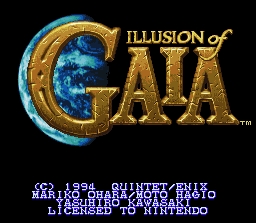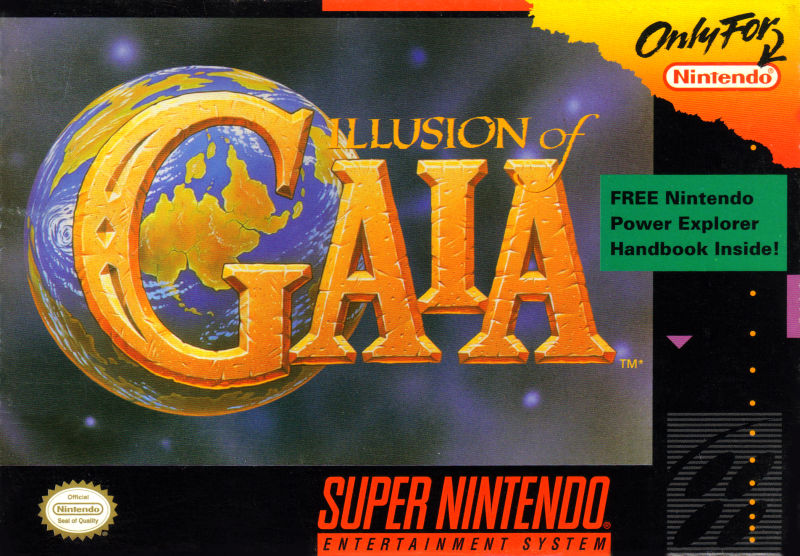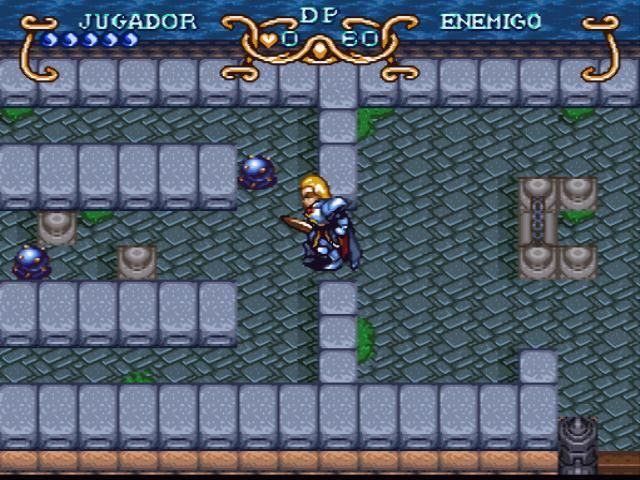Name: Illusion of Gaia
Developer: Quintet
Publisher: Nintendo and Enix
North American Release: September 1st, 1994
Console: Super Nintendo
Before we get into the article: if you like the reviews and Gold & Steel in general, a great way to help this page is to either buy our books from Amazon or Buy a Coffee! It’s the sure way to ensure that the content you like keeps flowing. Thank you for reading and supporting the page, and with that, let’s dive in.
If I were to describe Illusion of Gaia (or Illusion of Time, as it was known elsewhere) in a single word, it would be ‘weird’. It’s a word that can have several interpretations, and Illusion of Gaia fits nearly every one of them.
Illusion of Gaia came to North America in 1994 and was sitting on store shelves by September, all ready to go to homes during the holiday season. It made its debut beside other shiny, new RPGs like Final Fantasy VI and Breath of Fire while last year’s offerings like Secret of Mana and Lufia competed for further attention. As I said in the Donkey Kong Country write-up, 1994 was a tremendous year for gaming, and the RPG gamer in particular had a treasure trove from which to choose.
So, how did Illusion of Gaia compete with those offerings? What made it the purchasing choice for the RPG fan of 1994 over the games listed above and further options like Phantasy Star IV and Shining Force II on the Genesis?
For those who really dug Secret of Mana, the game might feel familiar to an extent; therefore, it might scratch the itch for those looking for something akin to it. The legions of Zelda fans looking for something to fill the void since A Link to the Past released in 1992 would also feel at home with the gameplay of Illusion of Gaia.
Gaia came to be thanks to a video game developer called Quintet. It’s two founders started off with a different developer called Nihon Falcom and got their start in the video game industry with Legacy of the Wizard and the first two games in the Ys series.

The pair left Nihon Falcom between Ys II and III, breaking off to form their own development company, Quintet. With Enix serving as their publisher, Quintet began making games in their own vision. The bulk of these games were action RPG’s, and the ones I have played all have that same, quirky weirdness to them that Illusion of Gaia has.
They started with Actraiser, a game that sees you take on the role of a god overseeing a continent’s worth of countries. They augmented this SimCity-style management mode with a side scrolling action platformer that felt to me like Magic Sword meets Iron Sword. The Sim City style overhead mode was praised, while the side scrolling was considered decent, so of course, when Actraiser got a sequel, they cut the overhead mode out entirely.


They followed that with Soul Blazer. While far from being Enix’s most renowned game, Soul Blazer set the stage for how Quintet intended to approach top-down action RPGs. It was far different from the platformer style they had worked on until that point, but Quintet showed a clear ability for making compelling games in that style. Two more games in that vein were produced by Quintet for the Super Nintendo. The first of that pair was Illusion of Gaia, and though Enix had been handling publishing duties for Quintet up to this point, Nintendo themselves handled this one, at least outside of Japan. Why? Excellent question, and… I don’t know. I was unable to find a sufficient answer to that one beyond Nintendo just deciding to do so. It’s just another weird piece of trivia for a game that embodies that word.
The third game Quintet made in the top-down style, which was never formally brought to North America, was Terranigma. While the rest of the world had the opportunity to experience the tertiary game, fans in North America were left in the dark until unofficial NTSC-region ports of the game hit the aftermarket years later. Even with Terranigma’s shelved release in North America, the trio of games have since come to be known in fan circles as the Gaia Trilogy. With that in mind, let’s have a look today at the The Empire Strikes Back and The Two Towers of the trilogy: Illusion of Gaia.



My playing history with Illusion of Gaia started in the early 2000’s and the dawn of console video game emulation on computers. I enjoyed playing JRPG’s on my old PC, and though I tried to give Illusion of Gaia a go via this method, I never got further than the first dungeon. Using a keyboard for the action elements just didn’t work out for me, and I passed on it to play other JRPGs and real time strategy PC games like Age of Empires.
Fast forward by nearly twenty years, and I found a copy locally for an awesome price and I snapped it up alongside a copy of Pilotwings. Now was the time to sit down and actually give this game a play.
Even from screen shots in old magazines and websites, I always thought Gaia was one of the prettiest games in the SNES library. You know what? Upon finally playing it on an actual TV, that notion was not dashed. Quintet always knew how to get the most that the console offered, and they kept proving that from ’90 to ’96. Whatever the year, Quintet had a release through Enix’s (and Nintendo’s, in this case) label, and each one was a showcase in the SNES’ graphical capabilities at that time. With IoG, there’s an immediate vibrancy to the aesthetic of the world. They chose a bright colour palette and large, animated sprites to represent the characters. The towns, cities, and dungeons all feature little animated touches to bring the world to life. It’s charming, in this way. Some might say oddly so, given the dark cloud of a narrative that tends to hang over the game at points. One of the little extras I always like was how the player character’s hair moved just a little when he would find himself in windy areas. It’s those little things that gave the game that little extra something. The game is just a joy to look at, and Quintet’s artistic stylings have allowed the game to age impeccably.
It plays impeccably too. For my money, the Zelda series sets the standard for how a top-down action/adventure game should feel, and IoG is right there with it. The controls are totally responsive and both running and walking are smooth. There are slopes that need a good running start from a higher slope to conquer, and the physics feels solid in these instances, (and they’re implemented well) and the hit detection is flawless. The only slight drawback is on a tiny amount of instances, Will’s primary form did an extra forward thrust with his attack that put him a space further than I wanted and he took a little damage from enemies. That’s the one measly gripe I had.
That’s a good jumping point to go into the main element of gameplay, though. Will, your player character, has three forms. His teenaged form is the primary, and it’s your avatar when anywhere outside of dungeons. Within dungeons, the save points are actually dimensional portals, and in those portals is sometimes the opportunity to transform into a hulking dark knight named Freedan. Let me tell you, once you switch forms, you feel as strong as you look. Freedan moves a touch slower, but hits like a freight train.
In the final quarter or so of the game, you get Shadow, who is a third form that combines Will’s speed with Freedan’s strength and a greater attack range than either of them. The form-switching is a neat mechanic that opened the developers to a wealth of ideas when building their puzzling dungeons. To that effect, most dungeons required you to switch between Will and Freedan to navigate certain areas with their unique abilities. In one of the final dungeons, you even have to switch between all three forms more than once.
The puzzle element in general was done quite well in IoG, if I’m being frank. There were certain tactics that seemed to crop up in every dungeon, but there was more than enough variety to keep everything interesting.
Though it is considered an Action RPG, the levelling is not the same as it is in say, Secret of Mana. To increase your stats, you have to clear every room of enemies. When the last one falls, you get a boost to your strength, defence, or health. It’s different, and it adds a bonus reason to ensure that you search every corner of each dungeon.
As for overworld travel, there really is none. You pick from a menu of three or four possible locations at a time and watch Will travel from point A to point B. It wasn’t an unheard of choice back then; the dungeon crawler RPG Arcana did something similar, for example, but it wasn’t an overly common way of doing it. The choice was an odd one, but in terms of weirdness that this game gets up to, it’s a footnote, at most.
Speaking of weird things about this game, another which struck me is the total absence of shops as they’re typically presented in RPGs games. Sure, there’s the occasional merchant you visit to obtain a specific item from, and there’s the guy who takes the red gems that you find lying around in exchange for rewards, but there’s no place to obtain supplies. You do pick up jewels as you go, and while you might think this is a currency, it’s no more a currency than collecting coins was in Super Mario Bros. They just grant you extra lives for every hundred.
Granted, there are no weapons or armour upgrades in the game, but without healing items at the very least, your inventory is limited to whatever few healing items you find, and there are a finite number of them. They do remedy this by allowing you to heal for free at save points, which is fine in the dungeons themselves. In fact, I don’t think I ever used healing herbs in the dungeons. It’s the bosses where you’ll need them, because most bosses can kill you in two or three hits flat. The problem is that once you figure out that the herbs have a set number of them in the whole game, you’ll have to start rationing. If you’re skilled enough, and in most instances, I was not, you might not need herbs in boss battles, though, so maybe it was a ‘me’ problem.
Now, with that said, dying at the bosses hands only sends you back to the start of the boss battle. That doesn’t sound terrible until I tell you that the developers decided that when you start over, you’ll only have half of whatever your maximum health is at that point. The bosses, though, will be fully restored. So now, these same bosses can kill you in one or two hits. Further adding to that raw deal is the fact that if you use your healing herbs, they won’t be returned to you should you die and start over. So, you’ll have less healing herbs than before, with half of your original health, and be expected to beat the boss that likely already wrecked you at full health. Yeah. Good luck with that. You’re better off just saving when all but the boss is beaten in the dungeon, go to the battle, and reset the game if you happen to die. It’s really the only way to deal with some of these bosses. Why’s that?

There’s a slight imbalance issue with the bosses. It’s actually noticeably reminiscent of Actraiser’s bosses, in that way. I’ll preface by saying that none of them ever feels completely unfair, and they all have recognisable patterns to them. The weird thing is that they deal an inordinate amount of damage with any one hit. It felt that way with all the bosses, too. I would not want to see how much more difficult the battles would have been if I wasn’t putting in the extra time to get all the stat boosts by beating regular enemies.
But the weirdness is not done! The bosses seem like they’re out of order. How so? Well, the first boss is one of the toughest in the game and there’s maybe one other boss battle that is a contender for that title. You could chalk that up to your relative lack of stat boosts at that point, but you fight him a second time at the end, and he’s every bit as frustrating. After him, the bosses get noticeably easier. I even thought that the final boss was less of a pain than this guy.
Further weird, what is it with Quintet and having you run the gauntlet against all the bosses in a given game at the final battle? That was extremely annoying in Actraiser, and it didn’t become a good idea by Illusion of Gaia. I mean, I will say that at least Illusion of Gaia gives you a break between bosses during the gauntlet to heal up, and there’s even a save point near the start, but damn, Quintet, there are better ideas out there than boss gauntlets.
Anyhow, there’s more weirdness ahead, but it’s not in the gameplay. I will say though, that said gameplay is solid, even with the choices surrounding the bosses. For even when the bosses can be a nuisance, I was still thoroughly enjoying myself playing this game. It just required a slightly different strategy than the game makers intended.
No, the real weirdness of Illusion of Gaia is in the story, and it’s time to rip the weirdest Band-Aid of all off and talk about it. Spoiler alerts ahead, by the way.
In a nutshell, the story is about a young man whose father disappeared mysteriously. Wait, didn’t I just cover this in Chrono Cross? Nope, this is different. This young man can still telepathically talk to his father… Sorta. Anyway, this lad was all casually hanging out with his pals, as teenagers are wont to do, and a dimensional rift opened. A medusa-looking statue tells him that he’s the chosen one to save the world, and off he goes to do just that, with a host of non-playable, supporting characters in tow. Said cast includes, but not limited to, his four friends, a dainty princess, and her relatively intelligent pet pig.
As he goes, he starts visiting fictional towns that are all located near dungeons that share names with real world locations like Incan Ruins, Angkor Wat, and the Great Wall of China. Now, none of these places is presented in any accurate manner beyond the general aesthetic, and their locations on the overworld don’t correspond with our real world. Still, the developers seemed to have thought that these ancient, historical sites should all be used to house this game’s bosses and the MacGuffins that the player needs to collect to save the world. It’s just yet another weird chip in the pile.
I digress, though, as I was talking about the story. In this world that borrows real name locations there are also supernatural inhabitants of both benevolent and malevolent natures, such as people who can turn into what is some sort of faerie-like creature. One of these faerie folk joins your group, and she seems to have some further, supernatural connection to the world and uses that ability to help you out with exposition at points.
You travel about from point to point with whatever city or town that’s nearest serving as a hub to get to the dungeons nearby. Once you complete a dungeon and move on, there’s no returning to the previous location. As you uncover the mysteries of this quasi-fantasy world, supporting characters get lost or take a break from adventuring, or are never heard from again until just much later. Then there’s that aforementioned pig, Hamlet. Major spoiler warnings ahead, skip to the next paragraph if that’s a problem, but I simply have to speak on this one because it made me go “WTF” aloud. You walk into a tiny, abandoned village with just two remnants of your party and the pig in tow. Once there, you’re approached after a time by its emaciated inhabitants. Upon observing the starving villagers with nothing but a campfire to their name, Hamlet recognises that they’re starving and jumps into the fire so that they might eat him. Yes, the pig sacrifices himself by self-immolation. He’s aware enough to know that he and his kind are part of the human diet and knows that his species are typically prepared by fire. This is a smart pig, whose actions clearly aren’t accidental and it came to the conclusion, “These people are hungry, so I guess I’ll die, then.” I mean, WHAT?! The owner of the pig is obviously horrified, and reacts accordingly, but that’s it. The game plays a sombre track, acknowledges the pig’s sacrifice, and we move on. Time for the next dungeon. I say again, WHAT?! The last time a game left me this utterly shocked, I saw Sephiroth descending from the ceiling with his sword.
I guess that begs to question how those villagers ended up in such a desperate situation, and the answer is another shocking turn this narrative takes. Every time you visit a city and think, “Gee, this looks like a nice place,” odds are its due to an economy that’s filthy rich due to slave trading. It’s a recurring theme in this, a seemingly standard-fare adventure RPG. I can’t think of any other game of any genre that even attempted to broach such a subject in this era of gaming, let alone one that’s so utterly forthright about the issue. As of 2019, there are upwards of 40 million people in slavery. The issue is still prevalent, despite an outward global ban on the practice. Human trafficking still exists, and in real life, Liam Neeson doesn’t show up to wreak havoc on the Parisian underworld in an effort to thwart it. In 1994, Quintet got candid about the subject, and encouraged people to reckon with this utter failing of humanity through a medium most famously known at that point for a story about plumber who battled bipedal, fire-breathing turtles. RPG developers like Square did and still do often tackle delicate issues, but slavery as a focal point of a video game was a new one to me. Even in 2020/2021, when I played Illusion of Gaia to completion for the first time. It was a bold move, and I applaud Quintet for taking it on.
However, it’s never resolved, and the player doesn’t truly get to play a meaningful role in dismantling the slavery system. I suppose that might be the intent: there’s no power upgrade or Thor-esque demi-god that can single-handedly solve such a prevalent issue. One of your supporting characters discovers that his parents accumulated much of their wealth via human trafficking, and, upon succeeding them, promises to undo their heinousness. That sentence right there is the only major resolution made towards the problem by the time the game wraps up. Otherwise, there’s little else that you, the player can do about it, other than a single trip to a mine to help the few slaves therein.
Atop all of that, there are ancient civilisations that you speak to in spirit form or you travel in time to interact with briefly. These peoples resemble our own ancient civilisations, at least visually, anyway. Beyond that, you’ll find angels hiding out on Earth, a sentient asteroid that apparently plays a role in everything, and philosophical ponderings on existence and all of that comes at you pretty quickly.
The end dungeon is the aforementioned boss gauntlet, and you run it while climbing the Tower of Babel, because why not, at this point. You fight the aforementioned alien asteroid first by walking on its face, then battling its final form. It wraps up with a deep discussion between the remaining two characters and the spirits of that player character’s parents, and when it’s all said and done, they tell you that your memory will be wiped and you won’t remember any of it anyway.
Yeah, it’s a headscratcher, there’s no denying it. They tried to cover a myriad of topical subjects, balancing them around a fantastical, sometimes touching adventure of a teenager and his friends, and then, yeah, none of you will remember anything about it.
I dunno what else to add to that. There’s the soundtrack, of course. Quintet hired Yasuhiro Kawasaki for the job and he did some excellent work here. There’s not a bad track to be found, and while there’s a little repetition (every city has the same track, for instance) the main dungeons all have their own distinctive tracks, and they’re all suited to their setting. Quintet figured out how to get the most out of the SNES’s audio capabilities back when they made Actraiser, and they built on it with every subsequent game.
All said, I recommend playing Illusion of Gaia. It’s a great game that holds up visually, plays well, and features some pretty clever dungeons. The story is bizarre, but it’s worth experiencing at least once. You can typically find it for a reasonable price in the used game markets, as it’s a fairly common cart. It’s also on the Nintendo Switch’s online service for free.
What do you think? Agree? Disagree? Feel free to let us know in the comments here or wherever you’ve seen this shared. If you have a suggestion as to what game(s) Chris should review next, let us know. We can also be reached at thegoldandsteelsaga”at”gmail.com.
As always, stay safe out there and take care.
*Some images sourced from Moby Games




